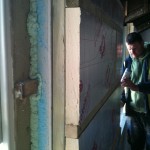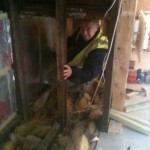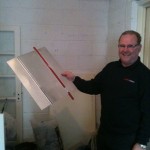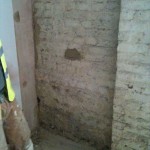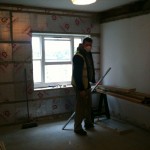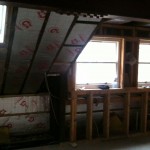So, continuing the theme of insulation as discussed last week – we have been using this week to insulate the exterior walls of the property – with 2 cross battened layers of Celotex (www.celotex.co.uk) thereby reducing cold bridging.
(cold bridging is mostly succinctly described on Wikipedia – http://en.wikipedia.org/wiki/Cold_bridging)
This insulation has been completed around the first floor, including behind the space where the kitchen will be – when we demolished this area we discovered that when they completed the previous conversion they didn’t include any insulation whatsoever in the dormer roof above the kitchen. This was an incredible oversight even if they weren’t aspiring to an eco-renovation.
So – with the help of Nick, our specialist small space giant – we have also insulated the exterior walls in the small space behind where the kitchen will be – see photo to the right.
We’re going to convert this previously “dead” space into storage for our clients – with two young kids you soon accumulate alot of things that you need to store.
We have completed the U value calculations for each of the buildings elements – our strategy is always to better 0.20 W/m2K – which while not as good as the Passiv House Standard (which we will come back to in a later post- 0.10W/m2K) we feel that this is an achievable target in all of the renovations works that we have been involved with. Our strategy with renovations is to to at the minimum to equal or be better than the prescriptive version of the AECB Silver Standard – see 
 AECB_VOL3_EnergyStandard_V6FINAL.pdf
AECB_VOL3_EnergyStandard_V6FINAL.pdf
So – our external wall reaches a U value of 0.19W/m2K with a make up: pb/100mm celotex/pb/40mm XPS/svag/brick inner/cavity/outer (we left the original XPS/pb covering simply to save on waste).
This calculation also shows that the element will be free from interstitial and surface condensation – which is a major point for our clients.
Alex also had a great meeting with Martin from Flomax Group – the installers of the Rehau underfloor heating system that we have decided to use – www.flowmax.co.uk – a plan has been devised and a solution to our logistical dilemma has been resolved – a solution based approach is the way we like to work too!
We have come across one wall on the groundfloor where a typical Brighton construction has been uncovered – bungaroosh (once again beautifully descibed on wikipedia – http://en.wikipedia.org/wiki/Bungaroosh) – in order to continue our insulation to the equivalent of 100mm PIR, with the minimal amount of space lost within the bedrooms – we have used Tri Iso Actis (http://www.actis-isolation.com/home.php?p=3&l=3) in a 25mm gap battened behind 50mm of PIR – the golden rule is to make sure that the insulating layer continues unimpeded.
It’s an unpleasant job working with Polyisocyanurate (PIR), but by equipping yourself with the right equipment – wear a mask, use a blade to cut the boards rather than a saw (to keep the dust down) – and you can shape the insulation to fit the existing rafters/joists as you can see in the photo to the right.
If you plan the installation right – you can minimise the amount of waste you produce in the process – and with the cost of removing/recycling waste this can have a significant impact on your budget.
This brings us nicely onto the last point for this blog – we were also able to remove and recycle all of the metal from the previous heating system – you’d be surprised what you can get for ‘clean’ copper….
So, there has been solid progress this week – next up, floating a new ceiling on the ground floor – installing the MVHR ducting, sound insulation, doorways, first fix electrics and plumbing… phew… still lots to do…. another busy week ahead.

